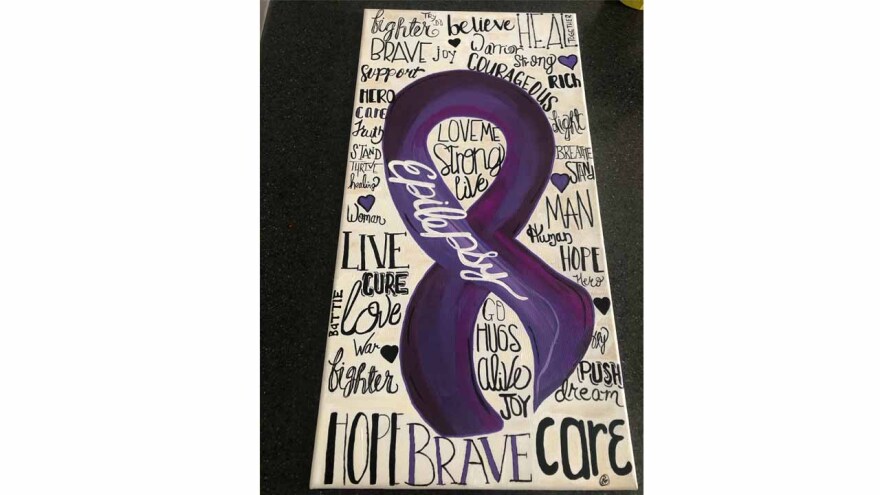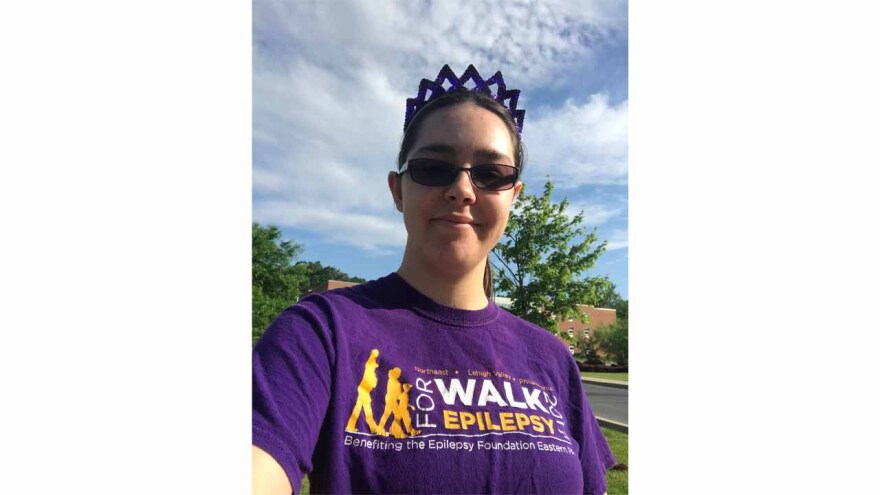UPPER SAUCON TOWNSHIP, Pa. — On Saturday, Kelsey Fulmer will participate in the Walk to END EPILEPSY — Lehigh Valley at Upper Saucon Township Community Park.
It will be the eighth Walk for Fulmer, 26, of Center Valley, but this year, she'll walk in new shoes.
She's gone out in public to ask her community for financial and gift basket donations to support her plight — to let the public know it's no picnic living with epilepsy and that others like her need to feel like they belong, every single day.
“I’m getting out of my comfort zone doing these baskets to auction off, putting up fliers,” Fulmer said last month from home.
“I'm talking to more people. I made a Facebook page to raise money for the walk. Last year, I hadn't even intended to participate.

“I'm getting more comfortable. I have a voice, and I want to speak up.”
The Walk, from 9 a.m.-noon at the park at 3231 Preston Lane, is free to anyone, but fundraising is encouraged.
As of June 2, Purple Princess — Fulmer's Facebook fundraising page and persona — had raised $1,890, surpassing her $1,200 goal.
The day everything changed
She was 21 when it struck.
“I can't even describe to you how scary that was, honestly," she said. "Everything was normal and then, wham!”
Fulmer was halfway down the aisle on the right-hand side of the Dollar Store in Quakertown in August 2016. She didn't know what was happening and was getting auras — the left side of her vision got blurry.
She couldn’t talk, couldn’t get words out, so she couldn’t say anything or call out to her mom or twin brothers in other aisles for help.
“I kept falling to the left," she said. "I couldn't control myself.”
Then again, the auras came. She hit the floor on her left side. She said that all she remembers is waking up in the emergency room.
It was epilepsy. A grand mal seizure had hijacked her brain.
She said she was told after the fact that one of her brothers lay on the floor so she wouldn't be scared when she woke up. He was “technically” the first thing she saw when she recovered, she said.
“It’s kind of all a blur," said Fulmer, 18 months older than her brothers and now 26. "Funny thing is, I woke up screaming, ‘Get them to go home!’ I didn't want my brothers to see me like this.
"It was more of a trauma thing for them. I'm protective, that’s how I am.”
Tonic vs. Clonic seizures
Renamed “tonic-clonic” seizures, episodes such as the one Fulmer experienced are bursts of electrical activity in the brain that can be “focal” — in one area of the brain, or “generalized” — where more areas are affected.
They can also start out as focal and become generalized.
In “tonic,” loss of consciousness occurs. This can last up to 20 seconds typically. Muscles become stiff and cause the person to fall.
In “clonic,” muscles take turns flexing and relaxing, or uncontrollable jerking movements, which is what people tend to think of when they hear the word ‘seizure.’ This phase can last up to two minutes.
Epilepsy left Fulmer feeling isolated. She watched her brothers live their lives.
“They have good jobs, are engaged, and it’s like, what do I have?" she said. "All of a sudden I have this diagnosis that doesn’t run in the family, I’m in this by myself and have no idea how to navigate everything.
“I was in my own little world. I lost friends and didn't want to be living like this. I didn’t know how to say this. My best friend — we would shout at each other. I realized that this is my cry for help.”

She was first put on the drug, Keppra, an anticonvulsant used to prevent seizures. The nausea and extreme fatigue Fulmer felt on it dulled her appetite.
“I was so underweight,” said Fulmer.
At 5-foot-one, she was at one point 109 pounds. She was told a feeding tube may be the next step to try to help her gain weight.
Life became a series of appointments. She saw a neurologist every few months in the beginning. Fulmer didn't care for the discussions.
“What they were telling me, and what I was researching, with the medication, was what I can and can’t do, like driving," she said. "And, one thing they weren't sure of was, could it be controlled with medication?”
"I was kind of vulnerable, I think. It was really hard living day by day."Kelsey Fulmer
Fulmer had to be monitored constantly, unideal for a young adult. From her parents, to grandparents, to co-workers at her job at Michael's crafts, everyone had to have a list of her medications, and instructions on how to handle a situation — what to do if a seizure struck.
“I was kind of vulnerable, I think. It was really hard living day by day,” Fulmer said.
She credits her family, in particular her two sets of grandparents, who were able to drive her where she needed to go, like school and work.
Depression is common among people who endure life with a chronic condition. Fulmer’s got so bad, she started to self-harm.
“The depression was the worst part of it,” she said. “My brothers were so athletic, on the move all the time. I was at home with family all the time. Don't get me wrong. I love my family and am so grateful for them. But college wasn’t for me. I don’t feel heard, I don't feel accepted. I used to slice my wrists with glass. It made me think that I’m not hurt.”
Thankfully, she kept up with her involvement with church and choir — she's been singing since age three and was selected to sing 'Take Me Out to the Ballgame' at a Mayfair competition, and family, helping out where she could.
Enter Louie.

He’s a petite, 15-pound, black poodle mix rescue from Animals in Distress in Coopersburg. For 11 years, he has been her constant comfort.
“I mean seriously, right when I got home from being diagnosed, he would not leave my side," Fulmer said. "He lays in my bed with me, we take long walks around the neighborhood, he’s constantly with me, he’s my buddy. He’s black. Maybe 15 pounds. Wakes me up at 7, cuddles with me, we have our set routine, including watching TV.”
Ellen Baca organizes the Lehigh Valley walk and knows how important it is for epilepsy patients to feel included. Fulmer met Baca through a mutual church friend.
Baca runs PACES, an eight-session epilepsy self-management program designed to increase the medical, psychosocial, and community adjustment of adults with active seizure conditions.
“It doesn’t define them," Baca said. "Anyone can get epilepsy. It’s important to make friends.
"That's what I’m hoping for with these walks, for people with epilepsy to make connections with others. It gets the community together so that they're not alone in their diagnosis.”
Baca does sleepaway kids camps, adult wellness weekends and other community events, as well as virtual support groups.
“It's a lot to handle for someone. They have stress, anxiety. Having epilepsy is like living in an earthquake zone. You never know when another seizure is going to come. How are my peers and co-workers going to react? Memory and cognitive issues are a big part of it, and sometimes the medication can cause that,” she said.
“It’s really important to meet others with epilepsy, to realize they’re not alone. They make lifelong friendships. That’s so important. The kids feel so isolated and they have the same struggles, triumphs.”
It’s been years since Fulmer's last seizure. She still works at Michael's, is still grateful for her family's tight-knit support, and says without them, she would be sitting in her room doing 'absolutely nothing.'
She's had the opportunity to bravely pay it forward.
“I witnessed a seizure firsthand when a girl collapsed. I just knew she was having a seizure,” Fulmer said. “I just know what to look for.”
She got the store manager, called 911, and grabbed some pillows and put them under her head.
“That happened to me, and somebody saved my life. I was 10 feet away from her. I knew what to look for.”Kelsey Fulmer
A woman in the register line asked how she knew what to do.
“I told her, 'I’m an epileptic. I have it, too,” Fulmer said.
She was praised for her quick thinking.
“That happened to me, and somebody saved my life," she said. "I was 10 feet away from her. I knew what to look for.”
It was pivotal in helping Fulmer take a few steps ahead in how she sees herself, sees her condition. She advocates for herself now, less afraid to speak up and live her life her way, out loud, with everyone else.
“If I don't, nobody else will,” she said. “That's what I've learned on my own. That’s why I'm walking in the walks. To advocate for other people.”
According to the Epilepsy Foundation of Eastern PA, 3.4 million adults and children live with epilepsy. There are over 40 types of epilepsy. Sixty percent of cases have no known cause.
In conjunction with the Walk, there are lots of activities for kids — obstacle courses, basket raffles, face-painting, making bracelets, and scavenger hunts. A potluck lunch follows. Registration is still open.
A $35 fee gets you a T-shirt, and, you can bring your dog.
How to help someone having a seizure
Benay Berger, Bethlehem Health Bureau nursing director says if you see someone having a seizure, either on the ground shaking or falling to the ground, protect them:
- You can’t do anything to stop it, but try to get them to the ground as gently as possible.
- Gently place them on their side if possible to avoid choking.
- Don’t put anything in their mouth; they’re not going to bite their tongue.
- Loosen any tight clothing or jewelry around the neck to ease breathing.
- Always call 911, and if you have the presence of mind to time the seizure, that helps the emergency personnel who will arrive to take care of them.
They will slowly come to, so stay with them until help arrives. Talk calmly to them, ask their name. They will be confused at first. There was a lot of electrical activity in the brain.
As for Fulmer, well, this Purple Princess warrior changed medications (Trileptal is working for her much better), and is happy to report she is a much healthier weight now that her appetite is back and she's feeling like herself again.
“I still try to keep going,” she said. “I was self-conscious at first, and I was the only person I knew who had epilepsy.
“I did my own research, and I'm in my 9th year at Michaels as a sales associate. I've gotten to know a lot of the families who shop there, because I'm always there all the time. I just tell them I’ve been diagnosed and that they have to just bear with me.
“They’re so nice about it.”


